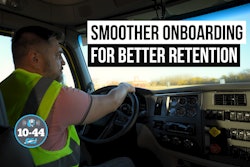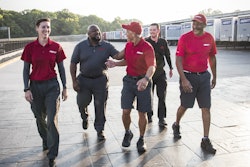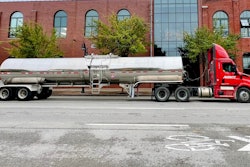When miles go down, driver turnover generally goes up, but that dynamic has changed in the last 18 to 24 months. Granted, many carriers are more worried about finding good rates and good loads right now than they are finding new drivers, but leads are down industry-wide, so when a driver leaves they’re harder to replace.
Speaker 1 (00:00):
The freight market sucks, but you can't let up on your recruiting and your retention efforts. Hey everybody, welcome back to the 10 44. I'm Jason Cannon and my co-host is Matt Cole. Many carriers are more worried right now about finding good loads and good rates than they are about finding their drivers, but leads are down so when a driver leaves, they're going to be harder to replace
Speaker 2 (00:20):
When miles go down, driver turnover generally goes up, but that dynamic has changed in the last 18 to 24 months,
Speaker 3 (00:32):
About 18, 24 months ago. What we saw was a, that pattern shift as drivers started to collectively realize that grass wasn't greener on the other side of the fence. And even though miles aren't great and rates are horrible, drivers aren't leaving, right? Drivers are staying longer. It doesn't mean they're staying forever, it doesn't mean any of those things, but they're definitely not as active on the market and they're definitely being Hoosier on the market. And what that means from a carrier's guide is that the average carrier over, if you compare June of 24 to June of 25, the average carrier on our platform is seeing about 5% fewer lead applications on the same store sales basis, but modestly more full applications. So less drivers in the market. Guys in the market are more motivated, and there's definitely what appears to be like a flight to safety from the driver's perspective.
(01:22):
Private fleets are having better luck. Bigger fleets are having better luck. The smaller the fleet, the bigger the drop in applications. I mean, the drivers are going, Hey, look, if I'm on the market now, it's, I'm not getting enough miles. Do I really want to go someplace that may not be open in six months? I mean, it's def facto what they're saying. And all the things that you might expect would happen are happening from the carrier side, the raising hiring qualifications, they're being a little Hoosier. They are reducing advertising as you might expect, and they're focusing on retaining the drivers that they have that are the best fit for that carrier because while turnover is down, it certainly isn't zero. And while recruiting is down, and it's still to your point, hey, whether you believe the definition driver shortage, I still know lots and lots of carriers who struggle to fill trucks when they empty, right? I mean, it's not easy to find people, whatever the cause is.
Speaker 1 (02:20):
Turnover indeed is not zero, but it's not awful. From a historical perspective, it was about 48% according to research conducted by the American Transportation Research Institute. And Tim says, personalizing the driver's experience with your fleet is key to keeping 'em there, and it's really not all that hard to do.
Speaker 3 (02:37):
Drivers are rational economic actors. They get that the freight market is down, they understand those realities, but they're looking for the fleets that have the most success in retaining people in the market we're in are the most relational and the most transparent with their drivers. Here's what's going on or why it's going on, and then we're going to deal with you to the extent we can, which is again, way easier said than done. Deal with those drivers as individuals with unique needs, whether it's home time or miles, whatever it happens to be. And it's not that you're going to make every driver happy all the time, but those are the strategies we're seeing, and it's more about how do you get that personal touch? That driver has the most luck in terms of retaining that set of drivers over the long haul.
Speaker 2 (03:26):
So how do you offer a personalized experience to drivers who may be thousands of miles away for weeks on end?
Speaker 3 (03:31):
I think it's a couple of different ways. I do think it's a, it's check-in. We have some clients getting a ton of mileage out of, no pun intended, just giving the guy, here's a cup of coffee on us, $10 on a truck stop gift card. The mechanics are hard or can be hard if you are not on the right system, but those types of things, it's not life-changing money. It's not changing the needle on their overall compensation for the year, but it's a way to say thank you in a tangible way. I think we see fleets doing some things around welcome 'em back to the terminal. Hey, make sure that when that driver is at the terminal, hey, the wifi works and things are relatively a buttoned up, and so the driver can really get the most out of their downtime. It's not big dollars, but it's a tangible way to send that signal to the driver. Hey, when you are in that touchpoint carrier's putting some effort in to make the driver know he's appreciated.
Speaker 1 (04:28):
Now, tough financial times is no excuse for not making sure that your driver application process doesn't stink. Tim says, if you don't do anything else, you need to put yourself in the driver's shoes and go through that application process.
Speaker 3 (04:39):
Go sit on a small screen with truck stop wifi or truck stop cellular coverage and go through your recruiting and onboarding process and find out where are the things you went, oh, everything from, oh, you had a beautiful picture of a truck on your website that took 45 seconds to download when you're in the middle of nowhere. Or, oh, hey, we do this process and it takes a driver three extra days to do this thing. What's interesting, what we see happen is when a driver first goes on the market, he generally speaking talks to between one and a half and two carriers. When he does lead app, the deeper he gets into the process with somebody, the more carriers he's going to submit, at least a lead app with the drivers that end up hiring, on average, they put in at least lead apps to five carriers.
(05:29):
And from the driver's perspective, that is exactly the right strategy in my view, right? Hey, before you make that lead, before you're off the road for a week, maybe two switching jobs, make sure you look at a bunch of different options. Well, if he's talking to five carriers, which carrier do you think he's most likely to end up with? Well, it's going to be the one that makes the processes easy as possible, everything else being equal, and sometimes processes accumulate and you add steps on, steps on steps, and it has the effect of making it harder and harder for that driver to get through the process. All good intended steps, but if you haven't looked at the process from start to finish in a few years, now it's a really good time to go say, okay, what is that?
Speaker 2 (06:12):
On the retention side, carriers need to understand that even that driver you're sure loves their job is putting out feelers and that pizza party you had for truck driver appreciation week last year probably didn't build enough equity to last until August, 2025.
Speaker 3 (06:26):
The average driver is on the market. What we see is three to four times a year, the average driver puts in at least one lead out. So that driver that you're thinking about retaining on average is testing the water frequently, and so the communication, the relationship isn't a, Hey, I did one thing in October and now we're good. Right? It's a journey, not a destination, and carriers that treat it that way tend to have better outcomes.
Speaker 1 (06:56):
That's it for this week's 10 44. You can read more on ccj digital.com. While you're there, sign up for our newsletter and stay up to date on the latest in trucking industry news and trends. If you have any questions or feedback, please let us know in the comments below. Don't forget to subscribe and hit the bell for notifications so you can catch us again next week.









